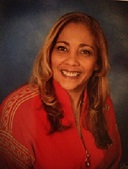
Purchase Tickets
The Real People in the Life of Madam C.J. Walker
April 6, 2020
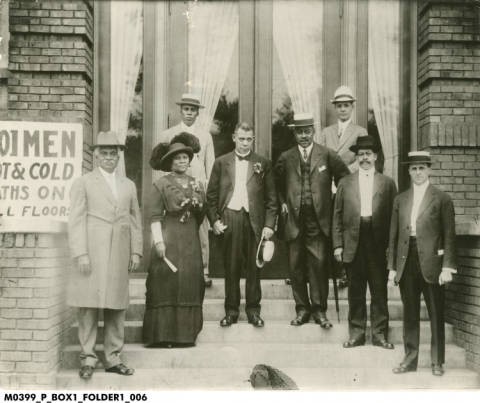
When you visit the Indiana Historical Society to see You Are There 1915 Madam C.J. Walker: Empowering Women you will meet the real characters in Madam Walker’s life. The creators of the Netflix series Self Made: Inspired by the Life of Madam C.J. Walker chose not to include many of the real people close to Madam Walker, instead they created fictionalized characters. The only place that you will see Sweetness, Addie Monroe, Esther and Cleophus will be on TV.
Let me instead introduce you to some of the real people you will meet from Madam C.J. Walker’s life that are portrayed in our exhibit: Alice P. Kelly, America Candace Pinkston, George Knox, and Violet Davis Reynolds.
Alice P. Kelly
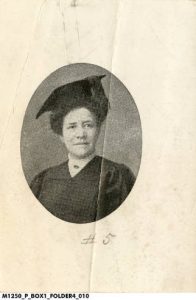
Caption: Alice Kelly in a cap and gown. Madam C.J. Walker Supplemental Collection, Indiana Historical Society
Alice Kelly was born December 16, 1882 in Alabama to Alfred and Leanna Rivers. Madam Walker met Kelly at a boarding school in Kentucky where she was a teacher. She trained to be a teacher and taught Latin at the African American Eckstein Norton Institute in Cane Spring, Kentucky, an institution that provided both vocational and liberal arts education for newly freed African Americans.
Madam Walker had very little formal education and she offered Alice a job as her personal tutor and traveling companion. Ultimately, Kelly became the forewoman of the Madam C.J. Walker Manufacturing Company at the factory and headquarters in Indianapolis. During her 20-year tenure as chemist and forewoman with the company she was one of the few people entrusted with the formula for the Walker products.
America Candace Pinkston began working for Madam Walker as a sales agent in 1913. She was a graduate of Madam Walker’s Complete Course of Advanced Beauty Culture as well as Burnham’s School of Beauty Culture in Chicago. She was a highly skilled in the hair style they called marcelling, which used a variety of hot curling irons and created a look of finger waves. Pinkston owned her own shop for many years selling the Walker line and then later returned to work as assistant manager at the Madam C.J. Walker Manufacturing Company. Pinkston was born about 1891 in Hiseville, Kentucky and was married to a freight house laborer, James Ryle Pinkston.
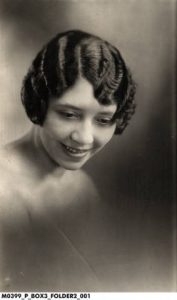
Caption: Unidentified Walker model showing Marcel waves. Madam C.J. Walker Collection, Indiana Historical Society.
George Knox
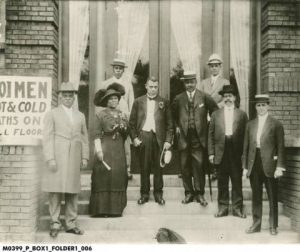
Caption: George Knox is pictured here to the left of Madam C.J. Walker at the dedication of the Senate Ave YMCA. Madam C.J. Walker Collection, Indiana Historical Society
George Knox was a successful businessman, political activist, community leader and newspaper publisher. He purchased the weekly Indianapolis Freeman Newspaper, the first illustrated African American newspaper with a national circulation, from Edward Elder Cooper in 1892. Knox was the president of the colored YMCA board and campaign chair to build a new colored YMCA. Knox, along with Madam C.J. Walker and more than 1,500 African American citizens, raised enough money to build the Senate Ave YMCA in Indianapolis. Madam Walker was the first African American woman to donate $1,000 to the building fund.
Knox was born during slavery in 1841 in Wilson County, Tennessee, near Nashville. He was born to an enslaved father, Charles Knox, and to a free born mother, Nancy Fisher Knox, who was sadly sold into slavery after the death of her mother. Knox became a free man after first serving in the Confederate Army as the servant of Captain James M. Phillips of the Eighth Tennessee Cavalry.
During a visit home, he amassed a group of fellow enslaved men to join the Union Army forces, serving as a cook, messenger, and servant to members of the Fifty-Seventh Indiana Infantry and the Fifteenth Indiana Infantry. As the servant to Captain Addison Dunn, he accompanied him on a furlough to Indianapolis. When Addison returned to battle in Tennessee, Knox stayed behind in Indianapolis, and thus he became a freeman. He learned the barber trade and later moved to Greenfield where he built a thriving barbershop. He was befriended by noted Hoosier poet James Whitcomb Riley. He married Aurilla Harvey and she taught him how to read and write. Knox moved back to Indianapolis and opened numerous barbershops dedicated to serving elite white men and counted President Benjamin Harrison as one of his clients. At the age of 54, he began to publish his autobiography Life As I Remember It, as a weekly serial in the Freeman, for a run of 54 chapters. He always planned to publish the autobiography as a book, but it never happened in his lifetime. Slave and Freeman: The Autobiography of George L. Knox was published in 1979 by Willard B. Gatewood, Jr., 52 years after his death. The Indiana Historical Society has a copy of the book, and researchers can find it by using our library catalog.
Violet Davis Reynolds
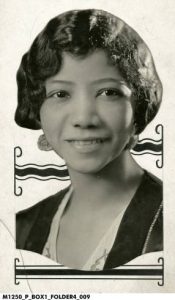
Caption: Portrait of Violet Davis Reynolds. Madam C.J. Walker Supplemental Collection, Indiana Historical Society.
Violet Davis Reynolds began her career as a secretary at the Madam C. J. Walker Manufacturing Company in 1915 when she was seventeen years old. She was cited as a bookkeeper and stenographer as well. Reynolds worked for the company for 68 years, retiring in 1982 with the title of Executive Director. After retirement she remained Chairwoman of the Board of Trustees. She had been named a trustee by Madam Walker herself, a position that began upon Walker’s death in 1919.
Reynolds was born August 23, 1897 in Birmingham, Alabama, to Major and Cornelia Davis. She married David E. Reynolds on June 14, 1919. She was a student of Alice Kelly’s at the Eckstein-Norton Institute in Cane Springs, Kentucky.
We all owe a debt of gratitude to Reynolds, for without her meticulous care and organization, the photographs, letters written by Madam Walker, F.B. Ransom, Lelia Walker, and the company’s business, advertising, and financial documents may have been lost to researchers. Thanks to her work, these items are available for researchers to view in the William H. Smith Memorial Library at the Eugene and Marilyn Glick Indiana History Center. For researchers who cannot visit us in person, more than 40,000 scanned items from the Madam C. J. Walker Collection are available online in our Digital Image Collection.




